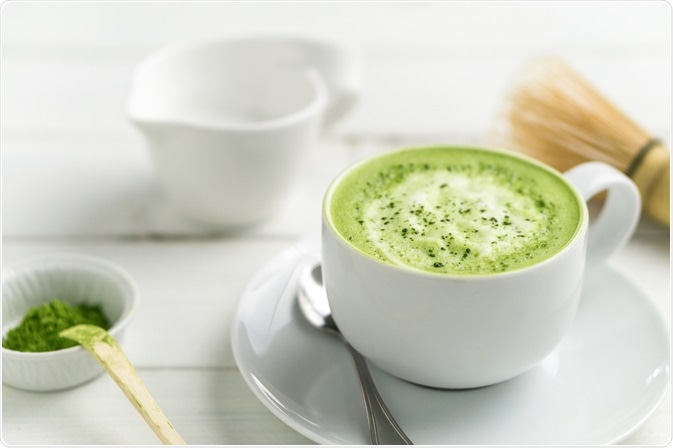The most commonly studied polyphenols (also called flavonoids) are procyanidins, quercetin, isoflavones (genistein and daidzein), and catechins. Catechins are a type of phenolic compound found in berries, tea, and cocoa, all of which are foods containing antioxidants thanks to this polyphenol.

Image Credit: Louno Morose/Shutterstock.com
All of the polyphenols share a variety of characteristics, in particular, their phenolic rings. These compounds are some of the most significant of all antioxidants that can be consumed as food. This feature led to the new, widespread use of the term ‘antioxidant’.
The total polyphenol concentration inside a selected food source is nowadays commonly observed by measuring the activity of said polyphenol, with one of the most common naturally occurring types being catechins.
How are catechins structured?
Catechin is a flavan-3-ol, part of the chemical family of flavonoids, a naturally occurring phenol, an antioxidant, and a secondary metabolite in certain plants. The catechin chemical family name originally comes from the word ‘catechu’, which is the name of the boiled extract (tannic juices) of the Mimosa catechu plant.
Catechin consists of two benzene rings (called ring A and ring B), as well as a dihydropyran heterocycle (ring C) with a hydroxyl group attached to carbon 3. Ring A is analogous to a resorcinol moiety, whereas ring B is akin to a catechol moiety.
There are also two chiral centers within this molecule, carbons 2 and 3, respectively. This, therefore, means that it possesses four diastereoisomers. Two isomers of the molecule are in a trans positioning, called catechin, while the other two in a cis configuration, called epicatechin. The most commonly observed isomer of catechin is the (+)-catechin version. The other stereoisomer can be called either ent-catechin or (-)-catechin.
What to catechins do in the body?
Tea catechins (polyphenols found naturally occurring in tea leaves) undergo a variety of metabolic changes once they are consumed orally, while a considerable percentage of them are excreted in feces.
Previous epidemiological studies have suggested that tea could potentially possess a protective quality against various human cancers, including both colon and rectal cancers. Furthermore, the antimicrobial properties of the catechins in tea leaves play various roles within the digestive tract.
In the human small intestine, catechins inhibit amylase enzyme activity, and a certain amount of catechin is absorbed into the main portal vein. Where catechins are known to have bactericidal properties, they do not have any effect on lactic acid bacteria.
It has been discovered in previous scientific studies that including tea catechins in a person’s diet for several weeks can decrease the volume of putrefactive products in the body, and increases the presence of organic acids via lowering of the intestinal pH.
The potential cancer-preventing properties of tea (such as green tea) have been portrayed using animal models for common cancers inside different organ sites, and have additionally been suggested by some more in-depth epidemiological studies over recent years.
Though the role of tea catechins when observing breast cancer treatment and prevention is wildly uncertain, there have also been various in vivo and in vitro studies that accurately portray the close association between green tea consumption by humans and the consequential decreased risk of contracting breast cancer.
For example, catechins have been found to inhibit DNA methylation through suppressing DNMTs (DNA methyltransferases), as well as increasing the SAH (a methionine cycle intermediate) levels, which resulted in the significant inhibition of tumorigenesis (the formation of tumors).
Catechins have also previously been found to suppress human cell proliferation and to also induce apoptosis (natural cell death) of breast cancer cells by facilitating cell cycle arrest. They also encourage calcium-associated apoptosis, thus promoting further cancer cell death via natural body systems (such as utilizing the protein P53).
Tea catechins have therefore been stated to inhibit the dangerous metastasis of breast cancer cells through the modulation of specific proteolytic enzymes, which consequently suppresses tumor formation and progression.
In conclusion, catechins are a naturally occurring polyphenol commonly found in boiled tea leaves, which can be utilized to not only reduce the risk of many common adult cancers but to also be a possible low-impact treatment for these cancers.
Sources
Williamson G. & Holst B. (2008). Dietary reference intake (DRI) value for dietary polyphenols: are we heading in the right direction? DOI:10.1017/S0007114508006867
Haya Y. (1997). Influence of Tea Catechins on the Digestive Tract. doi.org/.../(SICI)1097-4644(1997)27+<52::AID-JCB10>3.0.CO;2-N
Yang C.S. & Wang H. (2011). Mechanistic issues concerning cancer prevention by tea catechins. https://doi.org/10.1002/mnfr.201100036
Xiang L. et al. (2016). Suppressive Effects of Tea Catechins on Breast Cancer. https://doi.org/10.3390/nu8080458
Further Reading
Last Updated: Feb 3, 2020